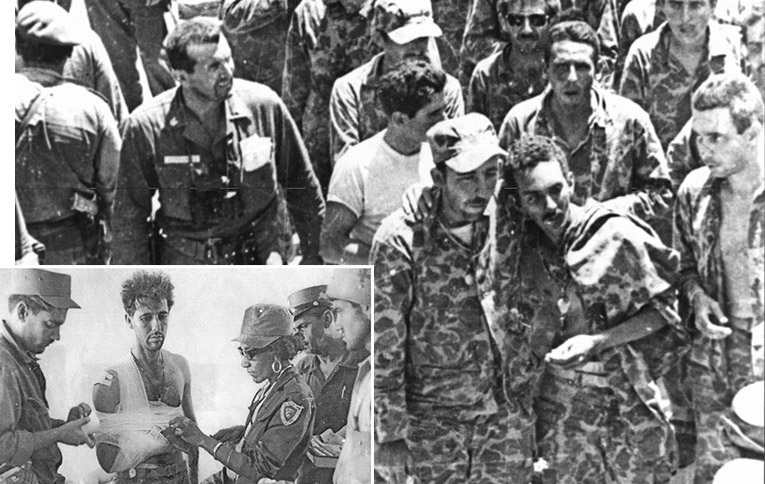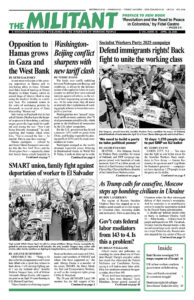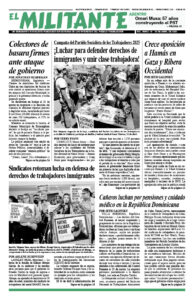Below is the preface to Revolution and the Road to Peace in Colombia: The Example of the Cuban Revolution, published by Pathfinder Press, a collection of writings by Fidel Castro. Available for the first time at the Bogotá, Colombia, international book fair, April 25 to May 11, it can be ordered from pathfinderpress.com now in English and Spanish. Copyright © 2025 by Pathfinder Press. Reprinted by permission.
Revolution and the Road to Peace in Colombia presents political lessons drawn by Fidel Castro as the revolutionary leadership of Cuba helped efforts to bring an end to a decades-long armed conflict in Colombia. By 2008 that war between the Colombian government and the Revolutionary Armed Forces of Colombia (FARC) as well as other guerrilla groups in that country had taken a toll of more than 220,000 lives over more than half a century.
The origins of this conflict date back to a period known in Colombia as “La Violencia” — a bloody factional feud from 1946 through 1958 between the Liberal Party and Conservative Party wings of the capitalist ruling class. Having been sidelined from the government for sixteen years, in 1946 the Conservative Party won the presidential election. The new regime soon unleashed violent repression and land evictions targeting Liberal Party supporters and others.
In 1948 longtime Liberal Party leader Jorge Eliécer Gaitán was assassinated, sparking a widespread popular explosion known as the Bogotazo. The young Fidel Castro, coincidentally in Bogotá at the time for a Latin American student conference, joined in the protests. In face of government and paramilitary assaults, Liberal Party followers and Communist Party members active in the countryside each organized separate self-defense groups among farmers, landless peasants, and other rural poor.
By 1954 the two guerrilla groups had begun operating together. In 1964 they formed the Revolutionary Armed Forces of Colombia (FARC), whose subsequent course under the leadership of Manuel Marulanda is the focus of much of this book. Marulanda, whose birth name was Pedro Antonio Marín, had led the Liberal Party guerrillas who joined the fused organization.
Following the January 1, 1959 revolutionary victory by workers and peasants in Cuba, guerrilla groups of different political origins emerged across Latin America to wage armed struggle aimed at overturning repressive capitalist regimes. By the late 1960s and early 1970s, most had been defeated or dissolved. Among the guerrilla organizations in Colombia were the National Liberation Army (ELN), which remains active today, as well as the April 19 Movement (M-19), Popular Liberation Army (EPL), and the Quintín Lame Armed Movement (MAQL).
As indicated by this book’s title, the articles, letters, and other writings by Fidel Castro collected here return time and again to lessons of revolutionary strategy from the Cuban Revolution, a revolution whose course and cadre were forged in struggle under his political leadership:
- How workers and peasants were organized and led to fight for and win state power in Cuba, opening the first socialist revolution in the Americas.
- How the proletarian internationalism and ethics that guided Fidel and the Cuban leadership from the outset were a cornerstone of their political course of relying on the revolutionary mobilization and political class consciousness of working people in Cuba itself.
- How they set an example for working people across the Americas and worldwide, including in the United States.
- And how this course of Cuba’s Rebel Army and July 26 Movement stood in stark contrast to that of the FARC and other guerrilla organizations in Colombia.

At the center of this small book are Fidel Castro’s introduction and afterword to a larger collection: La paz en Colombia (Peace in Colombia), published in 2008 by Cuba’s Editora Política under Castro’s political direction. That book attracted worldwide interest and was launched at an event attended by more than five hundred people during the International Book Fair in Caracas, Venezuela, in November 2008.
In addition to the central pieces by Fidel Castro contained in these pages, some chapters of La paz en Colombia not reprinted here summarize writings by Marulanda and other FARC leaders about that organization’s origins and political course. Others recount episodes from the Cuban leadership’s initiatives over the years to help negotiate an end to the war between the Colombian government and guerrilla organizations. They give accounts of discussions to advance that goal by Cuban government and Communist Party leaders with top figures of the FARC, ELN, and M-19, as well as Colombian government officials. Other material included by Castro in La paz en Colombia is described later in this preface, as well as by the Cuban leader himself in his 2008 introduction and afterword.
This Pathfinder Press collection — Revolution and the Road to Peace in Colombia: The Example of the Cuban Revolution — opens with a 1958 speech by Castro. It was broadcast over Radio Rebelde, the Rebel Army’s radio transmitter in Cuba’s Sierra Maestra mountains, during the revolutionary war to overturn the US-backed tyranny of Fulgencio Batista. Castro emphasizes the revolutionaries’ respectful and humane treatment of soldiers in Batista’s armed forces who surrendered or were wounded and captured by the Rebel Army — conduct that underscores the consistent record that distinguishes Cuba’s communist leadership.
* * *
This collection also includes two brief articles by Fidel Castro published in Granma, the daily newspaper of the Communist Party of Cuba, in July 2008, that lay the political groundwork he builds on in La paz en Colombia.
Fidel wrote the articles in the immediate aftermath of the July 2008 rescue by Colombian army troops of fifteen hostages held by guerrillas of the FARC. Among those freed were Ingrid Betancourt, kidnapped in 2002 while campaigning for president of Colombia; eleven Colombian soldiers and police; and three US citizens.
Castro condemned a brutal military operation that had been carried out three months earlier by the Colombian government with Washington’s complicity. He pointed to the regime’s bombardment “of a camp on Ecuadoran soil, where Colombian guerrillas and young visitors of various nationalities were sleeping.” He denounced “the shooting of the wounded at point-blank range, and the abduction of their bodies.” These actions, he said, were part of Washington’s attempts to exploit the kidnappings in Colombia to advance its imperialist interests in Venezuela, Bolivia, and elsewhere in the Americas.
Castro went on to explain his long-standing disagreement with the political course of FARC leader Manuel Marulanda, who had also been a central leader of the Communist Party of Colombia until the FARC’s breakaway from the CP in 1993. Marulanda had died a few months earlier in 2008.
Marulanda, Castro said, “envisaged a long and prolonged struggle,” noting that the FARC leader “had begun his armed resistance sixty years ago.” This was “a view I did not share,” Fidel added. “But I never had the opportunity to talk with him.”
The Colombian CP, “like all those in Latin America, was under the influence of the Communist Party of the Soviet Union, not of the party in Cuba,” Castro noted. It “never had the goal of taking power.” The guerrilla force the CP had organized was from its outset “a resistance front. It was not the basic instrument for conquering revolutionary power, as it had been in Cuba.”

Under Castro’s leadership, the Rebel Army and July 26 Movement acted on the conviction that a genuine revolution was possible only through the massive involvement of working people, independent of all of Cuba’s bourgeois parties. Fidel led a growing guerrilla force — the Rebel Army, composed overwhelmingly of exploited workers and peasants — to defeat the powerful military and police forces of a dictatorship backed by Washington and establish a popular revolutionary government. Support among working people for the revolutionary struggle expanded in cities and rural areas alike across Cuba. The fall of the Batista regime on January 1, 1959, came only two years after the Rebel Army’s first battle.
Using their new revolutionary government, workers, peasants, and agricultural workers began transforming themselves as they worked and fought shoulder to shoulder to transform social conditions and property relations in their country.
- They mobilized to eradicate illiteracy within one year and carried out an extensive land reform.
- They joined voluntary brigades that built much-needed housing, clinics, schools, and daycare centers.
- They formed popular militias to defend their political and social conquests against US-organized attacks.
- Faced with mounting aggression from foreign and domestic capitalists, they expropriated US-owned factories and plantations and then the properties of Cuban exploiters.
- From their very first days in power, they extended solidarity to those fighting imperialist oppression and exploitation around the world.
Cuba’s socialist revolution led to a revival of Marxist, genuinely communist leadership, on a mass scale for the first time since the October 1917 Bolshevik Revolution in Russia under V.I. Lenin.
In La paz en Colombia, Castro also expressed strong disagreement with the FARC’s practice of taking civilian hostages and its treatment of prisoners. “My opposition to holding prisoners of war — to applying policies that humiliate them or subject them to extremely harsh jungle conditions — is well known,” he said. “Nor was I in agreement with capturing and holding civilians who have nothing to do with the war.”
During the revolutionary war in Cuba, Castro wrote, “we handed over to the International Red Cross the soldiers and officers captured in each battle.” Otherwise, he said, no soldier of the class enemy’s armed forces “will ever surrender.”
The consistency of that political course is confirmed by two letters written by Fidel in 1983 and first published in his 2008 book in a chapter titled, “The value of principles.” Those letters, which are included here, were addressed to Colombian President Belisario Betancur, condemning the kidnapping of Betancur’s brother by the National Liberation Army (ELN).
* * *
Four years after La paz en Colombia was released, in November 2012, initiatives by the Cuban government led to the opening of negotiations between the FARC and the Colombian regime. With the agreement of both sides, those talks were conducted in Havana, with the governments of Cuba and Norway serving as hosts and guarantors.
In his July 2008 Granma articles, Castro had affirmed that the Cuban leadership was “in favor of peace in Colombia.” The goal of establishing “real peace, even if remote and difficult,” is the course “Cuba has advocated for that nation for three decades.”
At the same time, Fidel added that Cuba would “never support the Pax Romana” that US imperialism “tries to impose on Latin America.” For that reason, he emphasized, he was not calling on the FARC to lay down its arms.
In 2016 the Colombian government and the FARC signed a “Final Agreement to End the Conflict.”
Negotiations with the ELN were suspended in 2019 by Colombian President Iván Duque. Restarted in 2022 by newly elected president Gustavo Petro, the talks were again suspended by the government in January 2025, as the ELN renewed the fighting.
With unrivaled imperial hypocrisy, the US rulers have lied about the Cuban government’s political role in facilitating negotiations with the ELN as a pretext to redouble their relentless drive to crush the example set by Cuba’s working people and leadership in making a socialist revolution. Since the victory of the Cuban Revolution in 1959, these ruthless efforts have included everything from direct military aggression in the early years, to nonstop terrorist activity staged by counterrevolutionary groups from US soil, to a decades-long US economic embargo against the Cuban government and people.
These policies have been carried out by every single US administration, Democratic and Republican, since 1959, including both the Donald Trump and Joseph Biden White Houses. As part of this brutal political, economic, and diplomatic war, Washington has included Cuba on its list of “State Sponsors of Terrorism.” That outrageous measure imposes even more suffocating sanctions that block Cuba’s access to the world banking and credit system. That, in turn, squeezes off vital imports of raw materials, fuel, medicine, and food, sharply intensifying hardships for the Cuban people.
As its pretext for keeping the Cuban government on its “terrorist” list, the US government cynically charges that Havana refused the Duque government’s demand to extradite ELN officials who had traveled to Cuba for the peace negotiations. Cuban leaders replied that complying with that demand would be a flagrant violation of protocols agreed to by all sides. The Norwegian government — like Cuba, one of the talks’ four guarantors — backed Havana’s refusal to extradite the ELN leaders.
In 2022, the government of President Gustavo Petro in Colombia withdrew the extradition demand and resumed talks with the ELN. Colombia’s Congress gave the Cuban government an award for its selfless efforts toward ending the armed conflict. This was another blow to Washington’s slanderous charge that Cuba’s revolutionary government is a “state sponsor of terrorism.”
To this day, however, Cuba remains on Washington’s list.
* * *
Revolution and the Road to Peace in Colombia: The Example of the Cuban Revolution, concludes with two items from the pages of the Militant, a socialist newsweekly published in New York.
One is a rebuttal of a 2008 article by a well-known US academic, James Petras. Petras’s polemic was pointedly headlined, “Fidel Castro and the FARC: Eight Mistaken Theses of Fidel Castro.”
The other is a 2023 talk presented in Havana by Mary-Alice Waters, a leader of the Socialist Workers Party in the US, underlining the principled consistency over decades of Fidel Castro’s communist course. Its title captures a theme that runs throughout the pages of this book: “Proletarian internationalism is not only a foreign policy, it is an expression of the revolution itself.”
“If Fidel belongs first to the working people of Cuba,” Waters says, “he also belongs to oppressed and exploited peoples the world over.”
* * *
As an aid to readers of Revolution and the Road to Peace in Colombia, a timeline and a glossary can be found at the end of the book to identify terms, places, individuals, and dates of events.
In preparing the 2008 book, Fidel decided to open La paz en Colombia with two programmatic foundations of Cuba’s socialist revolution, issued in 1960 and 1962. “From the earliest days,” he wrote in his brief introduction to the book, “the Cuban people gathered in mass rallies to send their message, in the First and then Second Declarations of Havana, to the fraternal peoples of Latin America.”
The Second Declaration was presented by Fidel to a rally of more than one million in February 1962. Workers and peasants poured into Havana from across the island to repudiate threats to the revolution the previous week by the Organization of American States, dubbed by them the “Yankee ministry of colonies.”
The conquest of workers power is needed not just in Cuba, the Second Declaration boldly declared, but in countries throughout the Americas. “What unifies and incites” the capitalist ruling classes, it said, is “fear that the plundered people of the continent will seize the arms from their oppressors and, like Cuba, declare themselves free people of the Americas.”
“The duty of every revolutionist is to make the revolution,” the declaration asserted. Everywhere in the Americas, including the United States, and everywhere in the world.
That is what this book is about. Above all, that’s what the Cuban Revolution and the millions of working people who made that revolution and continue to defend it have lived up to.
April 2025


